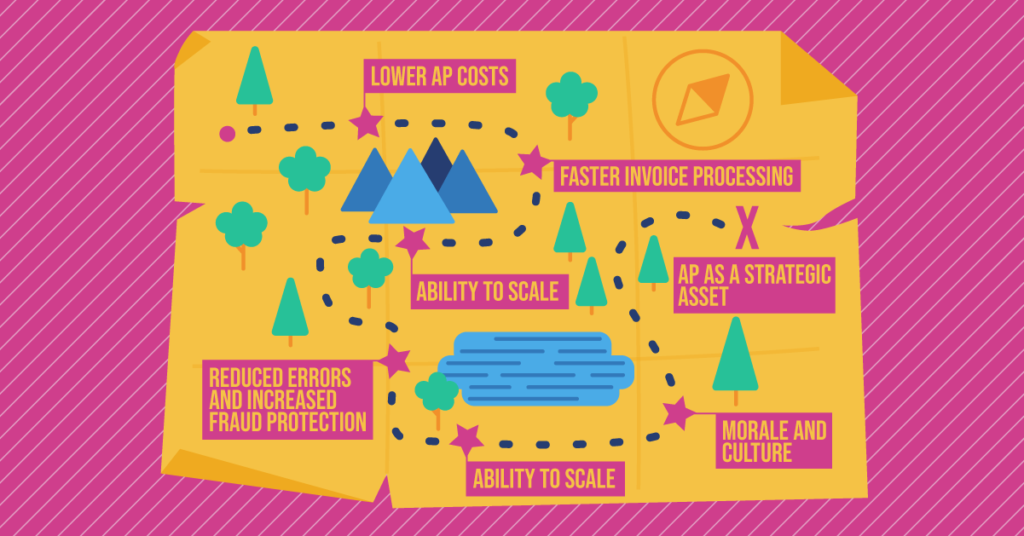What Will Your Department Look Like After AP Automation?

As a Controller or AP leader which oversees the Accounts Payable function, have you thought much about AP automation?
When we say AP Automation, we’re not talking about outsourced coding centers that take 1-2 days to manually code an invoice, or spotty Purchase Order (PO) matching, and the occasional coding error. We’re also not talking about the clunky or outdated AP software which doesn’t communicate with accounting systems in real-time, or the software that comes without support.
We’re talking about true AP automation and what it means to turn invoices into information by instantly extracting information and automatically populating that data into your systems. In like fashion, what modern AP automation software looks like — from intuitive interfaces specific to each user role — to what training and hand-holding support means for your organization now and in the future. We’re talking about the associated benefits of AP automation, the tactical how-to’s of a 24-hour implementation, and how your processes remain in place.
With this in mind, have you thought about what AP automation could mean for your organization, your team, or even your own role? For many AP leaders considering moving to an accounts payable automation platform, their questions are less about the technology and more about the people:
- Will there be mass lay-offs?
- How can team members transition into other roles?
- Can my team still add value beyond day-to-day AP operations?
AP automation is indeed a part of digital transformation at an organization, and not something to be taken lightly.
In this post, we’ll take a step back and talk about the high-level effects of implementing AP automation at your organization, what changes you can expect to see, and also cover some information and best practices about preparing for a transition.
Let’s get started.
Accounts Payable: Pursue Automation or Remain Analog?

For many financial executives, the writing for AP automation is already on the wall—it makes sense fiscally and strategically, but any mention of introducing a tech-enabled AP department is likely to raise this (legitimate) question:
Why should you automate accounts payable if the current process is working fine?
It’s a fair question, but also readily answerable with strong evidence. Here are a few talking points you’ll want to know.
Lower AP costs
When it comes to non-revenue generating departments like AP or HR, corporate executives are always looking to cut costs. If your executive team discovers that they could be saving money within their AP department, you want that to be your idea, not theirs.
Businesses can spend upwards of $30 per manual processed invoice versus just $3 per automated invoice. Depending on the number of invoices your business processes each month, this could easily add up to hundreds or thousands of dollars of savings each year.
Faster invoice processing
Purple, a mattress company based in Utah and Stampli customer, has increased its invoice processing speed by 63% with AP automation. It used to take 8 days to process and approve an invoice and now it only takes three. Automation helped them gain speed in data capture, but also approvals.
Imagine what a 63% increase in processing speed with no extra labor could do to your invoice backlog.
Ability to scale
As we mentioned, AP automation allows you to take advantage of lower costs and faster processing times without increasing AP staff headcount immediately. Your AP team can now do more (a lot more) with less.
If AP bottlenecks are stunting growth at your company and annoying your suppliers, you really should consider exploring an AP automation solution that can introduce scalable processes that will set up your organization for long-term growth.
Reduced errors and increased fraud protection
There’s nothing that increases costs (and frustration) quite like issuing duplicate or fraudulent payments—not to mention the time you lose going backward to rectify the situation.
AP automation helps you shore up your internal payment controls to reduce the likelihood of accounts payable fraud while also creating an easily accessible ‘paper’ trail documentation of invoice actions, approvals, and payments.
Morale and culture
AP staff members don’t like tedious, manual invoice management tasks like data entry, and the younger crop of talent won’t either. By automating those types of processes, AP professionals can actually use their human skills like creativity and intuition to focus on more strategic work that can improve the organization’s bottom line like dynamic discounting.
The future of AP employment is more fulfilling and more flexible work, which is possible through AP automation.
AP as a strategic asset
Those in or who work with the AP department understand the function is a strategic asset to the company.
While the entire organization may not share that same idea, AP automation can help you flip that on its head; to help Controllers go from order takers to strategic partners.
Since your department will now be enjoying faster invoice processing times, greater accuracy, and better compliance with tax laws, the company benefits with peace of mind knowing the AP practices are in good health. Additionally, you may be able to find early payment discounts with your suppliers, thereby increasing the bottom line of the company from within the accounts payable department!
AP automation platforms give you enhanced reporting in real-time. This allows you to have far more productive conversations with the CFO about the cash position of the company, which is extremely useful information when thinking about budgets for product launches, capital improvements, staffing, M&A, and expansion.
So that’s a view of the benefits an organization will receive after AP automation, but what will that actually look like in real life?
What Does Accounts Payable Look Like After Automation?
Automation certainly changes an AP department, and of course, that’s by design. Here are a few things you can expect to see in a tech-enabled, modern AP department.
Teams can punch above their weight
When you have computers take care of the bulk of the busy work—such as data capture, entry, and coding—there simply isn’t an immediate need to increase headcount as invoice volume increases.
Purple, the mattress company we mentioned earlier, was just about to add a third full-time employee to its AP staff to handle their growing number of invoices. With Stampli, they didn’t have to hire anybody, but they also freed up their current AP staffers to pursue work that could actually add value to the company, such as expanding vendor relationships and delivering goodwill via modernized A/P workflow to the rest of our organization.
Working better with other departments

One thing that a lot of people don’t realize is that when your AP process works efficiently, 96% of the people interacting with an invoice are actually not AP employees—they’re invoice approvers.
Think about your current AP workflow and how it affects the rest of your company, or better yet, ask those approvers what they think of the overall approval process. Likely, they’re not aware of a ‘process’ and instead deal with an amalgamation of emails, phone calls, and office drop-ins to get their approval.
With Stampli, both your AP staff and the entire company can work directly ‘on top’ of the invoice, keeping all data contextualized for easy comprehension and conflict resolution.
Forget about ‘Let’s all get on the same page.’
Let’s all get on the same platform!
Making the Transition to AP Automation
At this point, you might be thinking:
“This sounds grand—in the outcome, but also in the scope of the project.”
And you’re absolutely right. AP automation is a form of digital transformation, and it is not always such an easy transition, but not for the reasons you may think.
For example, our team of AP heroes at Stampli can have our AP automation platform implemented at your organization within days—integrating your accounting and ERP systems, training your staff, you name it.
No, the harder part of making the transition to AP automation is convincing your executive team, as well as your AP team, that the accounts payable utopia you’ve described to them is actually a very real possibility. Some people just aren’t ready for the fact that there’s a new and more efficient way to do things, but it’s true!
If you need help winning over your organization to the idea of AP automation, send them a link to our customer success stories. You’re sure to find one of our existing case studies that can help explain the unique problems AP automation can solve.
Or, you can always book a call with one of our AP heroes who can show you the system in action. Either way, good luck!